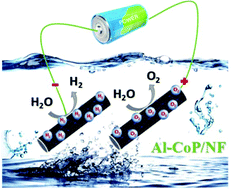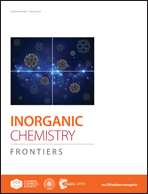Self-supported Al-doped cobalt phosphide nanosheets grown on three-dimensional Ni foam for highly efficient water reduction and oxidation†
Abstract
Developing efficient non-noble-metal electrocatalysts for overall water-splitting is still a great challenge for future renewable energy conversion and storage systems. Herein, cross-linked Al-doped CoP nanosheets on three-dimensional (3D) nickel foam (Al-CoP/NF) are synthesized by a simple low-temperature phosphidation method using a CoAl layer double hydroxide precursor and exhibit high activity and good stability towards the hydrogen evolution reaction (HER) at all pH values, with low overpotentials of 51 mV (0.5 M H2SO4, pH = 0), 66 mV (1.0 M KOH, pH = 14) and 83 mV (1.0 M PBS, pH = 7) to achieve a current density of 10 mA cm−2. In addition, this self-supported electrode shows excellent activity towards the oxygen evolution reaction (OER) in alkaline media, affording an anodic current density of 10 mA cm−2 at an overpotential of 330 mV. As a result, Al-CoP/NF as a bifunctional electrocatalyst can afford a current density of 10 mA cm−2 at a cell voltage of 1.63 V over a long-term overall water splitting operation in 1.0 M KOH. The remarkable catalytic performance of the self-supported Al-CoP/NF is closely associated with its outstanding structural advantages such as a 3D conductive framework, fascinating porous characteristics and Al doping. This study might open up a new route to improve the activity and durability of self-supported electrocatalysts by heteroatom doping.



 Please wait while we load your content...
Please wait while we load your content...